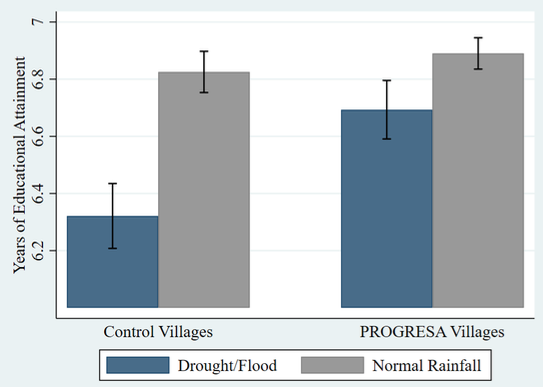
Mexico’s conditional cash transfer programme improved the life of disadvantaged children even when not explicitly targeted
Adverse events early in life, including during the foetal period, often have long-lasting negative impacts. The evidence for this is abundant and comes from multiple disciplines, including medicine, epidemiology (McBride 1961, Jones 1973, Stein et al. 1975, Barker 1990), and more recently, economics (Almond and Currie 2011, Currie and Vogl 2013).
The economics of early life shocks
Numerous studies have investigated the economic impacts of a wide range of early life shocks. These include extreme events like famines and disease epidemics, to more insidious health shocks, like maternal malnutrition and pollution exposure. From this large body of research, one important lesson has consistently emerged. The effects of the early life health environment are substantial, often persist into adulthood, and show up in many areas of life: health, education, and labour market outcomes.
The persistent nature of early life circumstances is particularly troubling for children in low-income country contexts. Not only are these children typically exposed to more frequent and more severe shocks, but they also tend to live in resource-constrained households. In contexts like these, what can governments do to help children who are affected by adverse events early in life? More specifically, to what extent can public policy help these disadvantaged children catch up to the rest of their peers? This is the question that our recent study seeks to answer (Adhvaryu et al. 2018).
Measuring catch-up after shocks: Challenges
At first glance, this question may seem relatively straightforward to answer empirically: simply compare the effect of a government programme on a “disadvantaged” group (children exposed to some adverse event), to the effect of the programme on a “non-disadvantaged” group (children who did not experience this adverse event). Yet there are two important challenges that this simplified investigation overlooks:
- Being selected as a programme beneficiary: Children who are beneficiaries of government programmes are usually different from children who are not. For example, public policy often targets low-income households. On the other hand, many programmes are not widely advertised or may be difficult to join, which means that some degree of parental awareness and education may be required. The true effect of the programme might not be captured by a simple comparison of the outcomes of targeted children to the outcomes of children who were not targeted. This comparison might instead simply reflect unobserved differences between the two groups.
- Whether a child is exposed to an adverse event in early life is usually not random: Parental or neighbourhood characteristics, for example, might play an important role. Therefore, even if the effect of a programme in one group differs from the effect of a programme in the other group, it would be difficult to determine whether this difference is due to the early life shock of interest, or other potentially important but unobserved characteristics.
The experiments: Evaluating the impact of Mexico’s PROGRESA
To account for these important challenges, our study design exploits the overlap in two “experiments”:
- Receipt of government programme
- Exposure to early life health shock.
Fortunately, there do exist government programmes that have been rolled out as randomised experiments, precisely to allow for rigorous evaluation. One such programme is Mexico’s landmark conditional cash transfer programme, the Programa de Educación, Salud y Alimentación (PROGRESA). For evaluation purposes, the programme was implemented experimentally in 506 rural localities. 320 randomly selected treatment localities started receiving programme benefits in 1998, while the remaining control localities did not join the programme until the end of 1999.
The programme provided cash transfers to poor families, conditional on a variety of education- and health-related requirements. We focus on the education component, which involved bimonthly cash transfers to mothers if their child attended at least 85% of school days. Today, the programme continues to operate on a national scale (under its most recent name, PROSPERA). Due to the evidence generated from PROGRESA, it has served as a model for conditional cash transfer programmes the world over.
Disadvantaged children exposed to early life weather shocks
Much work has documented PROGRESA’s success in improving educational outcomes (Schultz 2004, Behrman et al. 2011, Parker and Todd 2017), particularly for girls. Our focus is different: we assess PROGRESA’s ability to help disadvantaged children catch up. Specifically, we are interested in whether the programme yielded larger benefits for disadvantaged children, who were exposed to adverse circumstance early in life, compared to those who were not.
For this adverse event (our second experiment) we choose to focus on negative weather shocks during a child’s year of birth. These weather shocks satisfy two important criteria. First, weather is arguably random and therefore provides us with a “natural experiment” that addresses the empirical challenges described above. Second, in the agricultural setting we study here, weather plays an important role in determining how much income a household spends on nutrition and other inputs. Therefore, adverse weather events in the first year of a child’s life are an important driver of early life circumstance.
We show that a child who is born during a drought or flood is significantly more likely to be stunted in childhood than a child who is born during a year of normal rainfall. We argue that this is due to the negative effect of droughts and floods on agricultural wages (Bobonis 2009), and the resulting negative effect of droughts and floods on nutritional intake, which we also document using body mass index (BMI) as a proxy for nutrition. In short, in this setting, bad weather translates into lower-income, and lower-income in the first year of life translates into poor health in childhood.
Findings
We investigate how early life weather shocks affect educational attainment, and whether PROGRESA helps remediate them. Our main results are summarised in Figure 1, which highlights three important findings:
- Educational attainment is higher in PROGRESA localities compared to control localities. As previous literature has already documented, PROGRESA was successful in boosting educational attainment.
- Educational attainment among children born during droughts or floods is lower than among children born during normal rainfall years, indicating that the negative effects of early life weather shocks are not limited to the physical health effects described earlier: they also have implications for longer-term education outcomes.
- The educational attainment gap between the disadvantaged children and non-disadvantaged children in control localities is much larger than the corresponding gap in PROGRESA localities. This means that PROGRESA improved educational attainment for the disadvantaged children (who were born during a drought or flood) by substantially more than it did for children who were not exposed to these negative weather events. In short, PROGRESA was successful in helping disadvantaged children catch up.
Figure 1 Educational attainment by PROGRESA status and birth year rainfall

Notes: This graph reports educational attainment from the 2003 survey, among individuals aged 12 to 18 in that year. Error bars represent 95% confidence intervals.
Policy implications
The findings in our study have two important policy implications:
- Broad-based programmes like PROGRESA can indeed have targeted impacts on the most disadvantaged, establishing scope for remediation. This itself is a powerful result that creates optimism for the ability of such programmes to address systemic inequality deriving from early life disadvantage.
- Our study sheds light on the pathways by which this remediation occurs. We show that because the relative value of the cash transfer is largest, and the incremental cost of increasing educational investment is likely smaller for the most disadvantaged, they naturally exhibit the strongest response to the conditional programme incentives. That is, the programme did not need to be explicitly targeted in its provision to those children most disadvantaged in early life to benefit them most. This demonstrates how powerful such policies can be in combatting inequality, even when they are not explicitly designed to generate remediation.
References
Adhvaryu, A, A Nyshadham, T Molina and J Tamayo (2018), "Helping children catch up: Early life shocks and the PROGRESA experiment", NBER Working Paper 24848.
Almond, D and J Currie (2011). “Killing me softly: The fetal origins hypothesis”, Journal of Economic Perspectives 25(3): 153-72.
Barker, D J (1990). “The fetal and infant origins of adult disease”, BMJ: British Medical Journal 301(6761): 1111.
Behrman, J R, S W Parker and P E Todd (2011). “Do conditional cash transfers for schooling generate lasting benefits? A five-year followup of PROGRESA/Oportunidades”, Journal of Human Resources 46(1): 93-122.
Bobonis, G J (2009). “Is the allocation of resources within the household efficient? new evidence from a randomized experiment”, Journal of Political Economy 117(3):453–503.
Currie, J and T Vogl (2013), "Early-life health and adult circumstance in developing countries", Annual Review of Economics 5(1): 1-36.
Jones, K, D Smith, C Ulleland and A Streissguth (1973). “Pattern of malformation in offspring of chronic alcoholic mothers”, The Lancet 301(7815): 1267-1271.
McBride, W G (1961). “Thalidomide and congenital abnormalities”, The Lancet 2 (1358): 90927-8.
Parker, S W and P E Todd (2017). “Conditional cash transfers: The case of Progresa/Oportunidades”, Journal of Economic Literature 55(3): 866-915.
Schultz, T P (2004). “School subsidies for the poor: evaluating the Mexican Progresa poverty program”, Journal of Development Economics 74(1): 199-250.
Stein, A D, H S Kahn, A Rundle, P A Zybert, K van der Pal–de Bruin and L H Lumey (2007). “Anthropometric measures in middle age after exposure to famine during gestation: evidence from the Dutch famine”, The American Journal of Clinical Nutrition 85(3): 869-876.




